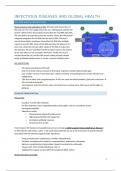Samenvatting
Summary Q8 Biomedical Evidence
Deze samenvatting omvat alle nodige leerstof nodig voor het Q8 tentamen; infectious diseases and global health, alzheimer's disease, renal disorders, nanomedicine en tot slot bioinformatics and big data. De samenvatting is gebaseerd op de lectures en ZSO's.
[Meer zien]




